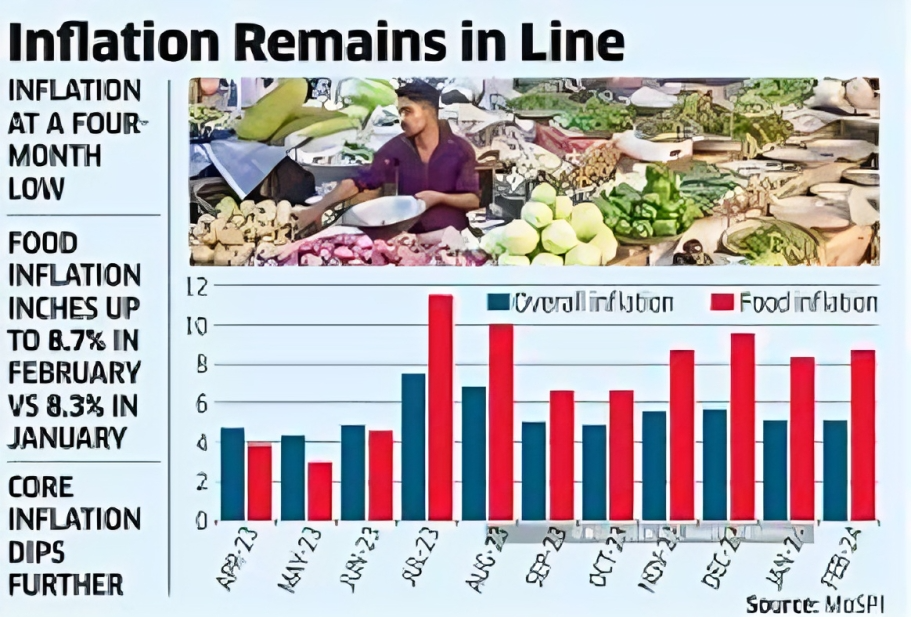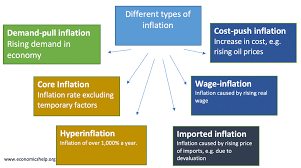Description
Daily Editorial Analysis
Editorial Analysis based on “Little respite: On food price gain” which was published in The Indian Express.
Introduction:
- India's retail inflation in April eased with the headline Consumer Price Index (CPI) inflation rate slightly dropping to 4.83%, which is the lowest in 11 months.
Current trends of inflation:
- CPI-based provisional headline print:
- The year-on-year retail price gains, measured by the Consumer Price Index (CPI), slowed slightly to 4.83% in April, marking an 11-month low compared to March's 4.85%.
- Acceleration in food price gains:
- Despite the overall slowing of CPI, food price inflation, based on the Consumer Food Price Index (CFPI), increased by 18 basis points to reach a four-month high of 8.7%. Month-on-month, food inflation accelerated to 0.74% from 0.16% in March.
- Rural-urban disparity:
- Rural consumers experienced higher inflation rates compared to urban counterparts, with both food and broader headline inflation reflecting faster price gains. Rural CPI stood at 5.43%, while urban inflation was notably lower at 4.11%.
- Impact of food price gains:
- Food inflation at 8.75% for rural consumers, exceeding the 8.56% for urban consumers, poses significant challenges, particularly considering food's essential nature in household expenditures.
- Pressure on food prices:
- Cereals, the heaviest weight in the food category, witnessed a 26 basis points increase in inflation to 8.63%. Rice prices were 14.3% higher compared to the previous year, indicating ongoing pressure on cereal prices.
- Vegetable and pulse prices:
- Inflation in vegetables remained in double digits for the sixth consecutive month, reaching 27.8% in April, while pulses continued their double-digit inflation streak for the eleventh month.
- Water scarcity and price stability:
- With live water storage at 27% of capacity as of May 9, below both the year-earlier and 10-year average levels, the outlook for price stability largely depends on the forecast 'normal monsoon' delivering adequate rains in the coming months.

Inflation:
- Inflation is a gradual loss of purchasing power, reflected in a broad rise in prices for goods and services over time.
- The inflation rate is calculated as the average price increase of a basket of selected goods and services over one year.
- High inflation means that prices are increasing quickly, with low inflation meaning that prices are increasing more slowly.
Types of Inflation:
- Demand-Pull Inflation:
- Occurs when aggregate demand exceeds aggregate supply, leading to increased competition for goods and services. This excess demand pushes prices upward.
- Cost-Push Inflation:
- Arises when production costs, such as wages and raw materials, increase, causing producers to pass on these higher costs to consumers through higher prices.
- Built-In Inflation:
- Also known as wage-price inflation, it occurs when workers demand higher wages to keep up with rising prices. This increase in wages leads to higher production costs, further driving inflation.
- Hyperinflation:
- Characterized by extremely rapid and out-of-control price increases, often resulting from excessive money supply growth, loss of confidence in currency, or economic collapse.
- Structural Inflation:
- Arises from imbalances in the structure of an economy, such as supply shortages, bottlenecks, or structural rigidities, leading to persistent upward pressure on prices.
- Open or Imported Inflation:
- Occurs when prices rise due to an increase in the cost of imported goods and services, typically influenced by changes in exchange rates or international commodity prices.
- Creeping Inflation:
- Refers to a gradual and steady increase in the general price level over time, often associated with moderate economic growth and monetary policy adjustments.

For detailed study on causes of inflation, Initiatives to control inflation, Way ahead, etc. Refer the article:
https://www.iasgyan.in/sansad-tv-air-summaries/tackling-inflation#:~:text=In%20India%2C%20the%20Ministry%20of,also%20used%20to%20measure%20inflation.






